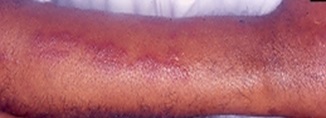According to the US Food and Drug Administration (FDA), “cosmetic” means (1) articles intended to be rubbed, poured, sprinkled, sprayed on, introduced into, or otherwise applied to the human body or any part thereof for cleansing, beautifying, promoting attractiveness or altering the appearance, and (2) articles intended for use as a component of any such articles; except that such term shall not include soap. This includes facial makeup, skincare items, perfumes, hair and nail products, shaving gels or creams and any personal hygiene product such as toothpaste or deodorant. Toiletries such as bath gel or feminine hygiene wash are categorized as cosmetics. Adverse reactions caused by cosmetics are extremely common. It is difficult to estimate the incidence rate of adverse reaction secondary to cosmetics as most people do not seek medical advice and simply discontinue use of product suspected of triggering a reaction.
Sign and Symptoms
There are certain areas of presentation where contact dermatitis due to cosmetics is frequently well-recognised because of their frequency of contact with cosmetic products i.e. face, eyelid, neck, hands, scalp and anogenital region. Therefore any parts of the body may be affected. The patients may experience burning sensation, pain, itch, swelling, redness or even blisters at the sites contact with cosmetics (Figure 1). There are many kinds of adverse reactions caused by cosmetics which include contact dermatitis (irritiant or allergic), urticaria, photosensitization, pigmentary disorders, damage of hair and nails, acneiform eruptions and exacerbation of a pre-existing dermatosis.
What are the common substances implicated?
The common substances in cosmetics that may cause contact dermatitis include formaldehyde-releasing preservatives, fragrances, dyes, permanent wave solutions in hair care products, resins in nail polishes and antioxidants in cosmetics. There are other preservatives such as paraben or thimerosal that may occasionally cause similar problem.
How do we make the diagnosis
A thorough history taking with a careful physical examination is crucial for the proper diagnosis and management of contact dermatitis to cosmetics. If suspected, a patch test is used to confirm the diagnosis of cosmetic induced allergic contact dermatitis.
How to minimize or avoid contact
The mainstay of management is avoidance. Once the offending cosmetic allergens are ascertained, proper education will be given to patients. They are advised to carefully check the ingredients of cosmetic products before purchase in order to avoid contact again with the offending allergens.

Figure 1: Eczema appearing on the arm after using body cream
| Last Reviewed | : | 23 August 2019 |
| Writer | : | Dr. Tang Min Moon |
| Accreditor | : | Datin Dr. Asmah bt. Johar |
| Reviewer | : | Dr. Nazatul Shima bt. Abd Rahim |







